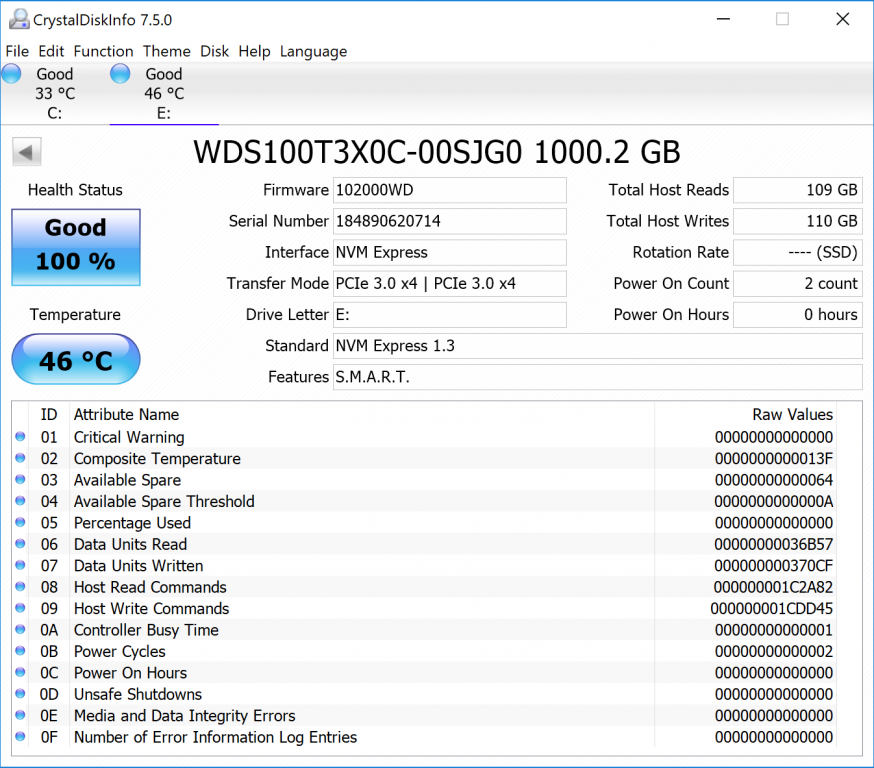CRYSTAL DISK INFO VER. 7.5.0
Crystal Disk Info is a great tool for displaying the characteristics and health of storage devices. It displays everything from temperatures, the number of hours the device has been powered, and even to the extent of informing you of the firmware of the device.
 Crystal Disk Info confirms the capacity, fact that we are running in PCIe 3.0 x4 and that the newest NVMe 1.3 protocol is in use, in addition to the information available through SMART attributes.
Crystal Disk Info confirms the capacity, fact that we are running in PCIe 3.0 x4 and that the newest NVMe 1.3 protocol is in use, in addition to the information available through SMART attributes.
ATTO Disk Benchmark is perhaps one of the oldest benchmarks going and is definitely the main staple for manufacturer performance specifications. ATTO uses RAW or compressible data and, for our benchmarks, we use a set length of 256mb and test both the read and write performance of various transfer sizes ranging from 0.5 to 8192kb. Manufacturers prefer this method of testing as it deals with raw (compressible) data rather than random (includes incompressible data) which, although more realistic, results in lower performance results.
We see a bit of a hiccup at the 128MB read test sample, but other than that, these are excellent results coming in dead on spec with 3.4GB/s read and 3GB/s write.
CRYSTAL DISK BENCHMARK VER. 5.5.0 X64
Crystal Disk Benchmark is used to measure read and write performance through sampling of random data which is, for the most part, incompressible. Performance is virtually identical, regardless of data sample so we have included only that using random data samples.
Crystal DiskMark once again comes in with results matching listed specifications, and are remarkably similar to ATTO which we dont see too often.
The toughest benchmark available for solid state drives is AS SSD as it relies solely on incompressible data samples when testing performance. For the most part, AS SSD tests can be considered the ‘worst case scenario’ in obtaining data transfer speeds and many enthusiasts like AS SSD for their needs. Transfer speeds are displayed on the left with IOPS results on the right.The AS SSD results aren’t as appealing as we might like to see but do get a first look at read and write IOPS which appear to be in the general ball park of listed specs.
Our results in AS SSD are fairly decent, if not a bit low. We would like to have seen the low 4k read IOPS come in a bit better, although 565K low 4K write IOPS is right on the money.
 The SSD Review The Worlds Dedicated SSD Education and Review Resource |
The SSD Review The Worlds Dedicated SSD Education and Review Resource | 

“WD speaks to SLC cache technology which we discussed in most recent reports. For the most part, this is sold as the reason for SSD performance gain, however, its use is twofold with respect to the newer 3D TLC memory as it is required to reach those performance benchmarks, unlike previous SSDs.”
I think it should be pointed out that SLC caching has existed in every SSD utilizing TLC NAND since its advent, including planar 2D TLC flash. The ADATA SU800, for example, (released in 2016) utilizes a massive dynamic cache buffer due to what was originally an immature controller (SM2258) and the Micron 32-layer 384-Gbit TLC NAND, which is very slow stuff.
In addition, SLC caching algorithms increase endurance, often substantially.
pSLC caching is one part of the reason that 3D TLC surpassed 2D MLC in endurance (substantially) and peak performance, while increasing density; very important for consumers of all types, as MLC is significantly more expensive.
You Said you were going to address the slc cache and potential problems when exceeding it… ??
In every test I see, in real world testing you always stay below that magical slc cache limit, so these drives come out of it looking very good. It’s a bit disappointing because I use a lot of different drives for different purposes and I have not found 1 single TLC drive that shows good sustained sequential speed e.g. Yet review after review, these drives are touted as “just as good” as 970 pro or similar. I guess it comes down to workflow or particular needs of the user. As an example I just bought a jms583 10Gps pcb and a “thumb” drive enclosure for it. Using a thermal pad to dissipate the heat through the aluminium enclosure, even with a Usb 3 host I can sustain ~usb3.0 limit for the whole transfer using an excellent mlc drive. With a tlc drive, the speed drops off so badly after the cache is full, that it prolongs your transfer operation by maybe 200%. Now the same would be true for situations where you generally were working with massive amounts of data.
I mean, every other professional review shows what happens when the SLC cache buffers are exhausted. The thing is, it’s not easy to do. It takes software written just to saturate 30+ queue depths at speeds greater than 3.8GB/s. The majority of consumers could never do this. Certain workstation workloads can, but those people are generally looking at MLC based SSDs.
You state that operations can be prolonged by 200%. 200% of what, exactly?